Ohio is a stunning state with a lot of opportunities to see birds, no matter the season. According to the Birds of Ohio Field Checklist, the state is home to at least 427 species. Many of these species are year-round residents that stay even when outside temperatures drop as low as 20°F. Since writing out all the birds that remain and migrate to Ohio during the winter would take too long, we’ve condensed it for you! Listed below are 15 birds that spend their winters in Ohio.
Bald Eagles
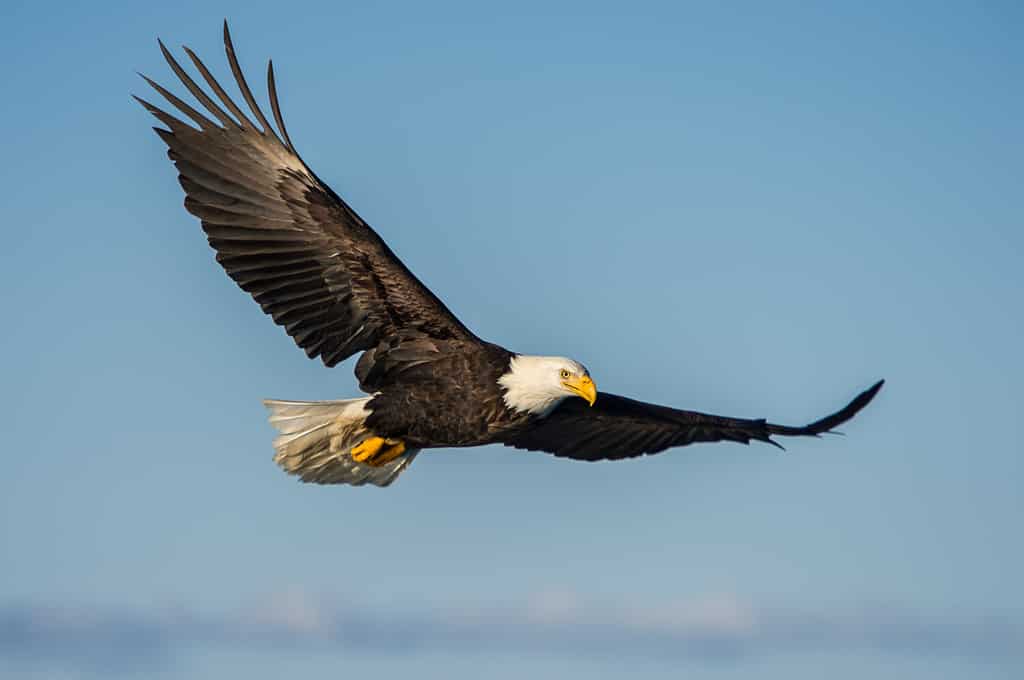
Female bald eagles are larger than males. They have a wingspan of up to 2 feet long.
©FloridaStock/Shutterstock.com
The first winter bird on our list is the bald eagle. Bald eagles are more commonly seen in Ohio during winter. Generally, you can start seeing these large birds starting in January. In Ohio, there are at least 707 breeding pairs, sometimes more, in the state. Your best chance of seeing a bald eagle in this state is to look near lakes and ponds, including Lake Erie.
Bald eagles are massive raptors with long and sharp claws. Their wingspan may be as long as 8 feet! Interestingly, female bald eagles are larger than males, sometimes as much as 2 feet in wingspan.
Snowy Owls

Snowy owls are also called polar owls, white owls, and Arctic owls.
©Carol Gray/iStock via Getty Images
Continuing our list of winter birds in Ohio is the snowy owl. If you aren’t sure what to look for, you may walk near a snowy owl without realizing it! These beautiful owls have a distinct snow-white look. They go by many names, including the polar owl, the white owl, and the Arctic owl.
Snowy owls are gorgeous animals. These magical birds are fluffy, with feather-covered feet. They are excellent hunters that consume a variety of rodents. Some animals they hunt are ducks, seabirds, and Arctic hares.
Barred Owls

Barred owls are listed as Least Concern on the IUCN Red List.
©FotoRequest/Shutterstock.com
Next on our list of birds that spend their winters in Ohio is the barred owl. Barred owls are very common in the United States. Currently, they are listed as Least Concern on the IUCN Red List. There are also various subspecies of barred owls, although the exact number is often debated and depends on the region. Generally, barred owls are grayish-brown or brown with white bars throughout their bodies. They also have large heads and eyes, and a white and brown vertically striped belly. According to the Ohio Department of Natural Resources, barred owls are the most common owl species in southeastern Ohio. Although uncommon, you may see one in western Ohio.
Carolina Wrens
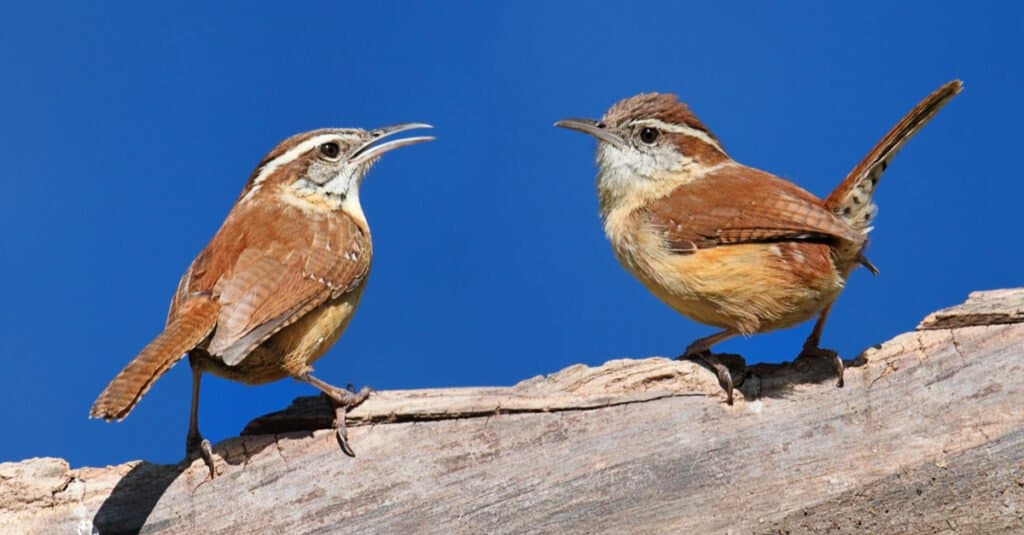
It is harder for a female Carolina wren to defend her territory without a mate.
©Steve Byland/Shutterstock.com
Carolina wrens also spend their winters in Ohio. These beautiful and vibrant birds are relatively small with a wide range in the eastern United States. They are about 5 inches long with an 11-inch wingspan. Carolina wrens weigh as little as 0.63 ounces. They are brown and orange birds with a distinct long white streak above their eyes. Carolina wrens search for food on the ground and in vegetation, like bushes. You can also sometimes see them feeding at bird feeders. These chunky birds mate for life and are very loud singers. Often, they are easier to hear than see.
Northern Cardinals

Male northern cardinals have bright red feathers, while females are duller.
©Bonnie Taylor Barry/Shutterstock.com
Northern cardinals are stunning birds. Male northern cardinals are easy to identify by their vibrant and bright red plumage. Fun fact, the cardinal is the state bird of Ohio. These cheery birds are loud singers. They have quite a few different vocalizations, which sound like repeated whistles. Northern cardinals vary a lot in appearance depending on the sex. Females, for example, are duller than males and have brown and orange feathers. Males have bright red feathers and a black mask around their beak.
Downy Woodpeckers

The downy
woodpecker
is the smallest woodpecker species in the United States.
©J Edwards Photography/Shutterstock.com
Even during the coldest of winters, you can still see birds in Ohio, like the downy woodpecker. Downy woodpeckers are the smallest woodpecker species in the United States. They are about 5.5 to 7.1 inches long and weigh around 1.16 ounces. Male and female downy woodpeckers look nearly the same, except females lack the red patch on the back of their heads. In Ohio, downy woodpeckers frequent bird feeders.
Great Horned Owls
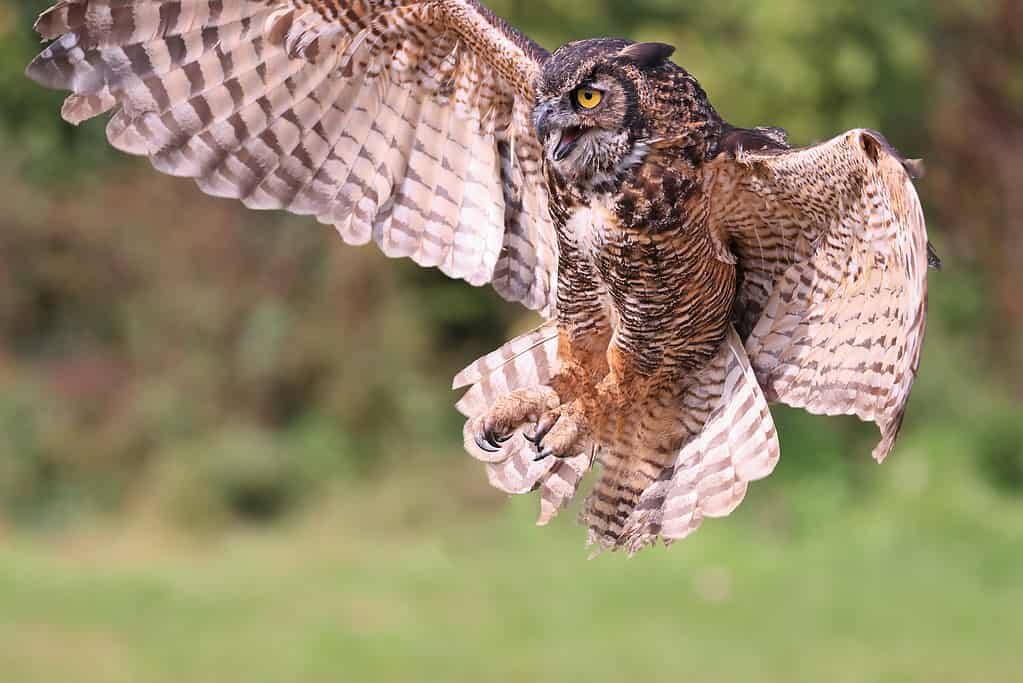
Great horned owls eat mice, rabbits, skunks, squirrels, rats, ducks, insects, and occasionally fish.
©Vladone/iStock via Getty Images
Another owl on our list is the great horned owl. Great horned owls are large birds and are very common in Northeastern Ohio. They are native to the Americas and are sometimes called hoot owls. On average, great horned owls are 22 inches long with a wingspan of up to 5 feet. Despite their length and wingspan, they only weigh about 2.7 to 3.5 pounds. These beautiful birds have a wide diet. They hunt mice, rabbits, skunks, squirrels, rats, ducks, insects, and occasionally fish.
Tufted Titmice
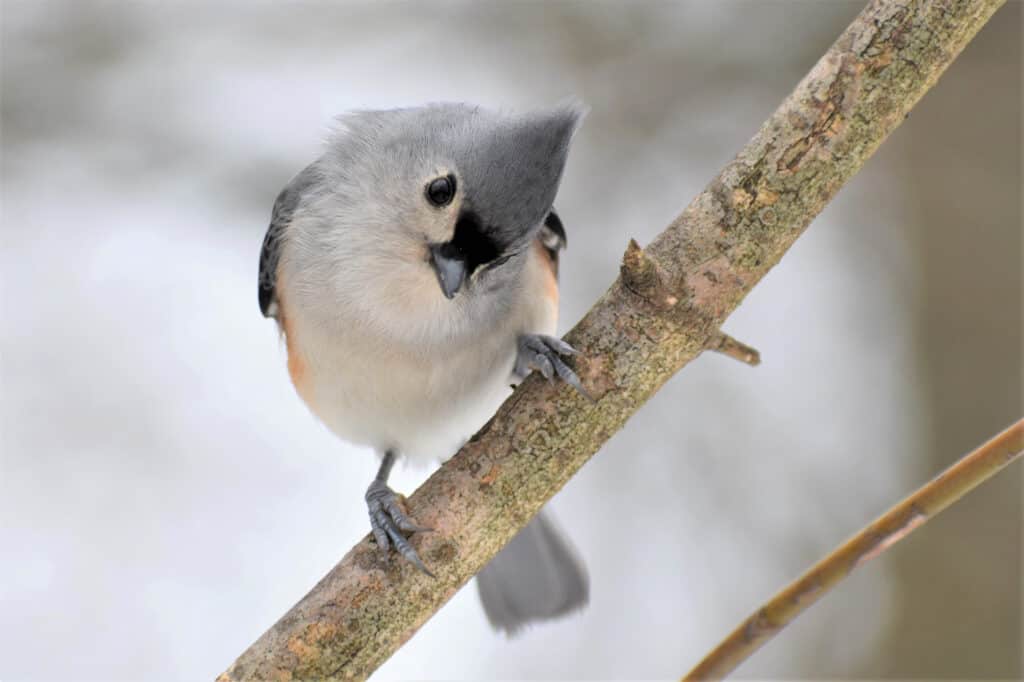
The tufted titmouse is a small bird in the eastern United States that weighs less than an ounce.
©Lester Graham/Shutterstock.com
The tufted titmouse is another common bird in Ohio. They frequently visit bird feeders, but can also be found in public parks and deciduous forests. Tufted titmice have large black eyes and grey bodies with white fronts. They are easy to identify from their rust-colored flanks.
Tufted titmice weigh less than an ounce and are very fast fliers. They are very common in the eastern United States and are listed as Least Concern on the IUCN Red List. Experts estimate there are between 8 to 11 million tufted titmice in the wild.
Tundra Swans

Tundra swans are nearly entirely white, except for a yellow spot below their eye.
©Sergey Uryadnikov/Shutterstock.com
Did you know there are also tundra swans in Ohio? Tundra swans are Ohio’s only highly migratory swan. Generally, you can see these large white birds from November through March. Tundra swans are almost entirely white, they also have a yellow spot below their eye and a black bill.
Tundra swans are great parents. They lay around five eggs at the same time and both parents care for their children 60 to 70 days after they hatch. Tundra swans eat fish, shellfish, and aquatic plants.
Red-bellied Woodpeckers

As confusing as the red-head may be, the red-bellied woodpecker does have a red belly.
©rck_953/Shutterstock.com
One of the most common woodpecker species in Ohio is the red-bellied woodpecker. They are listed as Least Concern on the IUCN Red List. Red-bellied woodpeckers have orange-red crowns and napes, not just red bellies! Most of their body though is gray. They also have black and white barred patterns on their back, wings, and tail.
Red-bellied woodpeckers are 9 to 10.5 inches long, with a wingspan of up to 18 inches. They may also weigh as much as 3.2 ounces. These lovely birds are also very vocal. They make churr and thrraa sounds. Like other woodpeckers, they consume insects by pecking at trees. Apart from insects, they also consume fruits and seeds.
White-throated Sparrows

White-throated sparrows can weigh up to 1.2 ounces.
©Fiona M. Donnelly/Shutterstock.com
Also on our list of birds that spend their winters in Ohio is the white-throated sparrow. White-throated sparrows are Ohio cold-weather residents. They are members of the family Passerellidae. These small birds weigh up to 1.2 ounces and are 5.9 to 7.5 inches long, with wingspans of 9 inches.
These adorable birds have two color variations. One color variation has a dark brown crown with a tan central stripe. The other color variation has a black crown with a white central stripe. Both color forms though have dark eyes and a white throat.
White-throated sparrows have a long range. You can find them as north as Canada, and as south as Florida in the United States and parts of Mexico. You can mainly find this bird species foraging on the ground for food by kicking its feet. They also frequent bird feeders.
Common Redpolls
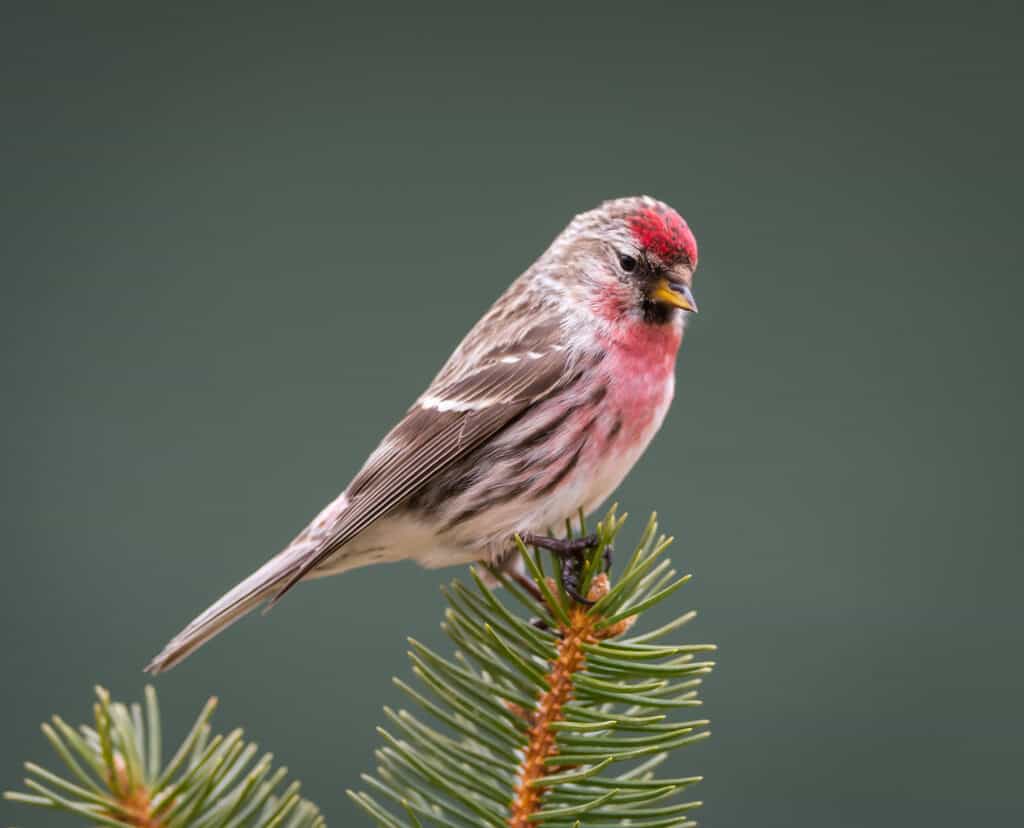
The common redpoll is rare in Texas. In Ohio, you can spot these birds throughout the state.
©FotoRequest/Shutterstock.com
Common redpolls also live in Ohio. They are fluffy, small birds in the Fringillidae family. On the IUCN Red List, this bird species is listed as Least Concern. They are very common in Ohio during the winter. Common redpolls are also sometimes called mealy redpolls. They mainly have grey, white, and brown feathers with a bright red patch on their forehead. They also have two pale stripes on the wings. While female and male common redpolls look similar, males have a slightly red front. They are small, generally weighing 0.4 to 0.55 ounces.
White-breasted Nuthatches

Another bird that frequents bird feeders in Ohio is the white-breasted nuthatch.
©J. A. Mikulich/Shutterstock.com
White-breasted nuthatches are super cute birds with a wide range. In most regions in their range, they are year-round residents. White-breasted nuthatches are very common permanent residents in Ohio. Not only can you find them feeding from bird feeders, but also nesting in trees. Currently, these lovely birds nest in all 88 of Ohio’s counties. They are the most common nuthatch species found in the state.
White-breasted nuthatches are known for their unique ability to run sideways and upside down. Generally, these medium-sized birds weigh up to 10.6 ounces and are 6.1 inches long. They are blue, grey, black, and white. Their plumage though varies depending on the subspecies, which can make it hard to tell apart female and male white-breasted nuthatches.
Snow Buntings

The female has less vibrant coloration than the male, giving it extra protection while nesting.
©xpixel/Shutterstock.com
Although snow buntings breed in the Arctic, you can find them in Ohio starting from October. They are adorable passerine birds with a unique distribution. You can find them in the United States, Norway, Germany, Ukraine, and Siberia. There seems to be no known limit to this bird’s northern range.
Snow buntings are ground-dwelling birds. While they can fly, they also jump, run, and walk. Interestingly, both male and female snow buntings change coloration depending on the season. For instance, during the breeding season, female snow buntings have black wingtips and rufous backs.
Blue Jays
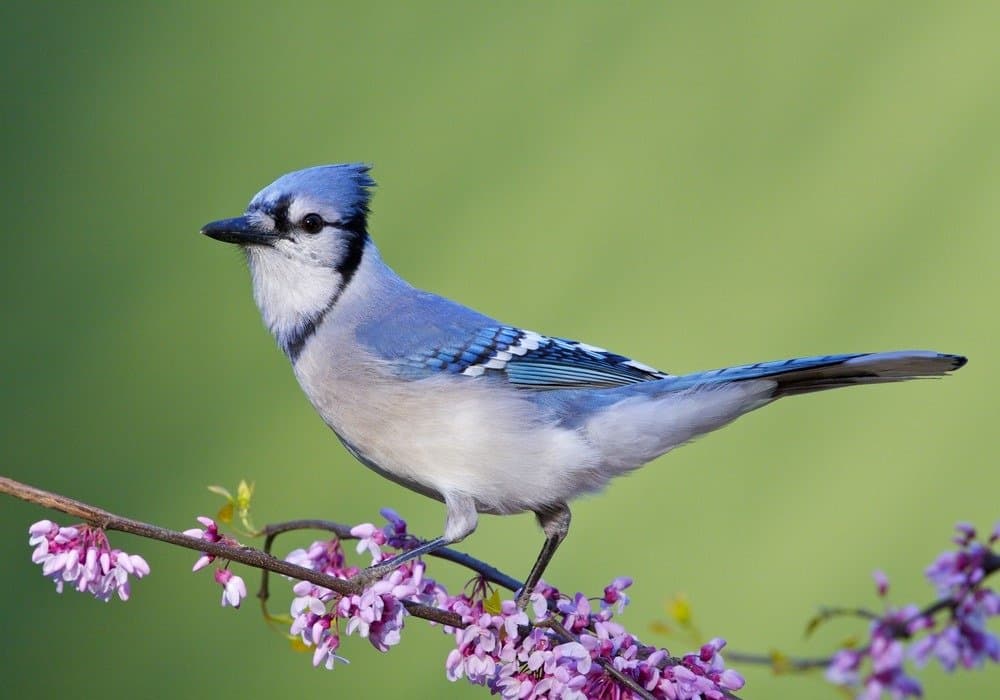
Blue jays are intelligent animals.
©Tom Reichner/Shutterstock.com
Last but not least is the blue jay. This gorgeous and vibrant bird is very common in Ohio. According to the Ohio Division of Wildlife, research estimates there are about 520,000 blue jays statewide. This only represents 2.2% of the global population. That’s a lot of blue jays!
Blue jays are one of the easiest birds to identify. This passerine bird can be found from southern Canada to the eastern and central United States. They are also as south as Florida and northeastern Texas. Blue jays are bold and aggressive. They are intelligent and fight larger birds like hawks and owls. Blue jays are also known to screech loudly, warning other birds of predators in an area.
The photo featured at the top of this post is © Guoqiang Xue/Shutterstock.com
Thank you for reading! Have some feedback for us? Contact the AZ Animals editorial team.






